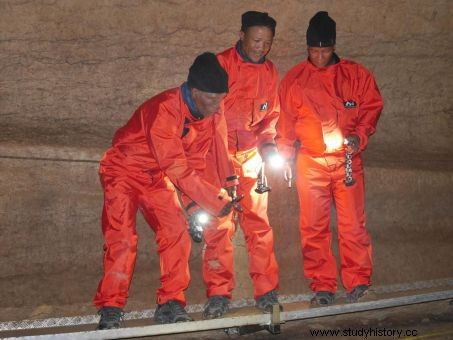Three San hunters from Namibia recently participated in the study of millennial footprints preserved in a cave in the Hérault. Amazing scientists with the extent of their knowledge.

San trackers came from Namibia to study 10,000-year-old footprints in the Aldène cave, in Hérault.
Since the passage of prehistoric men and women from the Mesolithic era 10,000 years ago, the dark corridors of the Aldène cave and its 10 km of development, in the gorges of the Cesse, in Casseras (Hérault), have not hadn't known such excitement anymore! From 1 st on October 10, 2018, three Namibians from the northwest of the San country - the only people still authorized to live by hunting and gathering in Namibia - came to support prehistorians as part of an international project called "Tracking in caves" initiated in 2013, as revealed by a recent documentary broadcast by France-3 Région, these African trackers put their skills at the service of science and archeology.
For 10 days, in the company of Andreas Pastoor and Tilman Lenssen-Erz from the University of Cologne (Germany), promoters of this program, Thui Thao, /ui Kxunta and Tsamgao Ciqae shared their multi-millennial knowledge with DRAC specialists (1) Occitanie, from UMR 5199 of PACEA (2) and speleologists from the Aldène Association involved in the "paleoanthropological study of human footprints from the Paul-Ambert gallery in the Aldène cave " .

The three trackers San Thui Thao, /ui Kxunta and Tsamgao Ciqae. © Drac Occitanie
"I was very impressed by this experience ", admits, still moved, Philippe Galant, the person in charge of the operation, joined by Sciences et Avenir. 40 m underground, in the lower levels of the cave, the three Namibian hunters thus analyzed 400 footprints preserved on a protected track 30 meters long dated 10,000 years. An entirely filmed experiment. "Aldène is one of the three major sites (with Burgos, in Spain and Niaux, in Ariège) on the quarantine known in the world holding human footprints. Its line of footprints was discovered in 1948 by Abbé Cathala (1890-1950) “, explains Philippe Galant.
"We had divided the track into 5 parts. Silently moving from sector to sector while moving on protective floors, the San observed each footprint individually for a very long time. Perhaps 40 minutes Only then did they start chatting with each other in their amazing click language (3) with the help of colored laser pointers, to compare their analyses “, continues the archaeologist. The researchers then witnessed a ballet of light beams before one of them – the only English speaker – spoke:“He explained to us that they had reached to identify the footsteps of each individual, but also to characterize their sex and age, sometimes associating behaviors with these footsteps!" , continues the specialist, still stunned. "According to them, the cave would have thus kept the trace of 26 people, men and women. In one of the sectors, footprints show that a woman would have loaded a child on her shoulders... Near the entrance, the footsteps of six individuals would indicate that they came out of the cave more loaded than they had arrived... ". "We were suddenly seeing Paleolithic hunters parade before our eyes!" , says Philippe Galant.

To work, the San trackers used different colored lasers. © Drac Occitanie
This is the third time that Thui Thao, /ui Kxunta and Tsamgao Ciqae have been invited to Europe. Since 2013, the German organizers of the project "Tracking in cave "have indeed well understood the benefit that they could scientifically derive from the remarkable skills of the San experts, who have already come to Niaux (Ariège), Pech Merl (Lot) and in the Caverns of Volp (Ariège). And these fine sleuths of Southern Africa brought information that modern-day prehistorians simply couldn't 'see' anymore."They opened my eyes to some aspects of our interpretations. These men have a living vision of the traces, because they work with them permanently. They know everything about morphologies, depressions, curves, orientations... “, adds admiringly Philippe Galant.
"The results of the analyzes carried out at Aldène will be compared with the data from the systematic inventory of footprints" , continues the researcher. An international inventory in the making. To carry out this work, a photogrammetric survey and a three-dimensional digitization of the gallery and its thousand-year-old remains were carried out by the University Institute of Technology of Nîmes (civil engineering), the Geomesure company and the Nîmes Speleological Association.
Intrigued beyond measure by their abilities, to the question "how do you manage to detect so many fascinating details?" Philippe Galant got this startling response from San trackers:"At home, from childhood, when we try to find out where our parents, our brothers or our sisters are…, we look on the ground!" . A reversal of vision of the world. To meditate.
The Mesolithic is the period (between about 9000 and 6000 BC in Europe) chronologically and culturally intermediate between the Palaeolithic and the Neolithic. The human groups of this period perpetuated a mode of subsistence based on hunting, fishing and gathering under a temperate climate close to the current one. The end of the Mesolithic is characterized by the transition from a hunting and gathering economy to an agro-pastoral economy resulting from domestication and the Neolithization process.
(1) DRAC:Regional Directorate of Cultural Affairs
(2) PACEA (Bordeaux):From Prehistory to the Present:Culture, Environment and Anthropology
(3) The l Khoisan languages or Khoi languages are spoken in southern Africa, primarily in Namibia, Botswana, South Africa, and Angola. These idioms owe their fame to the sounds emitted by clicking the tongue when pronouncing certain consonants, the clicks.
